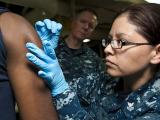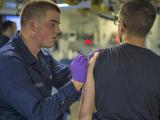Aug 8, 2003 (CIDRAP News) – As of Aug 1, the latest date for which data are available from the Centers for Disease Control and Prevention (CDC), 38,062 healthcare workers and first-responders have received smallpox vaccinations through the federal program announced in late 2002. Texas has vaccinated the most, with 4,241, and Florida is next with 3,791. Some states have very few vaccinees, such as Nevada with 17, Rhode Island with 35, and Arizona with 39. The total number of persons vaccinated is less than one tenth what the Bush administration had initially recommended for phase 1 of the program, which was to have been complete several months ago.
Despite these disappointing number, CDC Director Julie L. Gerberding, MD, MPH, told the Senate Committee on Health, Education, Labor, and Pensions late last month that the importance of the smallpox vaccination continues. She cited a number of reasons for the lagging vaccination rate, including the low perceived threat of an attack now that the Iraq war has ceased. She said in an interview with the Associated Press that "It concerns me very much that people have been lulled into a false sense of security about the smallpox threat. Nothing has changed our estimate about the threat of smallpox."
Continuing concern about possible adverse effects of the vaccine is another reason for the slowed program, said Gerberding in her Senate committee testimony. She pointed out that there have been fewer adverse reactions to the vaccine than anticipated, crediting the low rate of adverse reactions to the efficacy of pre-vaccination screening. She added that the occurrence of possible vaccine-related heart problems in several vaccinees and the resulting recommendation that patients with risk factors for heart disease not receive the vaccine further restricted the number of eligible recipients. (These cases and their possible connection to the vaccine remain under investigation.)
A further factor noted by Gerberding were compensation concerns from those eligible to receive the vaccine. In April, Congress passed the Smallpox Emergency Personnel Protection Act of 2003, which established a no-fault program. Through this legislation, vaccine recipients can receive benefits or compensation if they suffer adverse reactions. Some observers feel that the hoped-for jump-start of the program expected from passage of this law was offset by waning concern over the smallpox threat when the Iraq war subsided.
Although the number of healthcare workers, public health officials, and first-responders vaccinated varies greatly by state, Gerberding told the Senate committee that all states have developed detailed pre-event and post-event smallpox response plans. She also said that public health teams across the nation could respond to a suspected smallpox outbreak within 6 hours.
Gerberding concluded her remarks by saying, "CDC has refocused it priorities to be sure the nation is prepared for all types of public health emergencies including biological, chemical, radiological, and conventional terrorist threats. CDC will continue to implement the successful strategies begun in previous years, while remaining flexible in its capability to respond to known and emerging threats."
See also:
Smallpox Emergency Personnel Protection Act of 2003 (SEPPA)
http://www.govtrack.us/congress/bills/108/hr1770
Marty Heiberg, Managing Editor, contributed to this story.




















